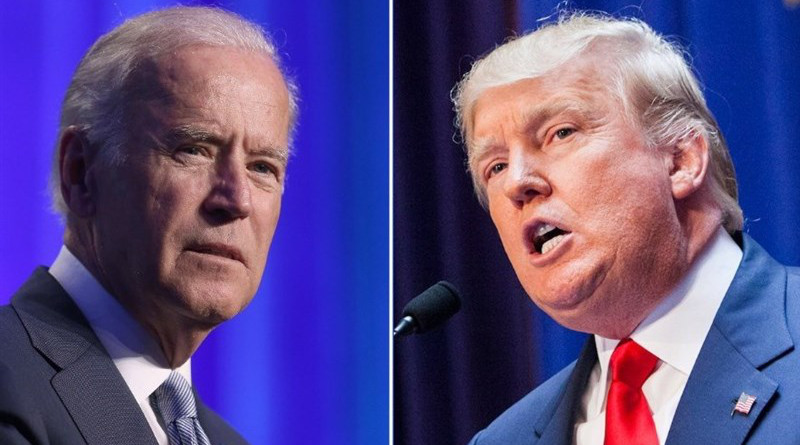Moderate Voters’ Receding Influence On US Politics – Analysis
By Arab News
By Kerry Boyd Anderson*
As the US election campaign season heats up ahead of the Nov. 3 national polls, many Americans who see themselves as political moderates feel discouraged. They are asking, at a time of historic levels of political polarization in the country, do moderates matter anymore?
Part of the challenge in answering this question lies in the different definitions of what it means to be a moderate or an independent. People often self-identify, which makes it difficult to come up with a standard definition in surveys. For example, some people consider themselves to be a moderate, but if they are mostly surrounded by a partisan community they might actually be strongly conservative or liberal compared to the US average. In polls, about 40 percent of Americans say they are independents — who might vote for either party — while, in reality, most “independents” consistently vote Democratic or Republican, often defined by pollsters as “leaning” toward one party or another. The Pew Research Center has concluded that only 7 percent of voters are true independents.
While acknowledging these nuances, it is still possible to identify moderates and independents as important groups in US politics. Moderates tend to prefer pragmatic policies over ideological conviction, listen to different perspectives, and are skeptical of radical approaches. True independents could vote either Republican or Democrat. Independents more broadly, including those who lean toward a party, tend to feel frustration with politics and have less positive views of candidates and the political parties. Moderates and independents often are not “swing voters” — voters who might switch parties in any election — but they are more likely to do so than voters with stronger partisan identities.
For decades, the US political system was largely based around trying to appeal to voters in the middle of the political spectrum. That strategy was essential at a time when people were more likely to switch parties or even to split their tickets — voting for Democratic and Republican candidates in different votes on the same ballot. Today, ticket-splitting is rare. As polarization has increased, more voters reliably vote for the same party.
At the national level, increasing polarization has made it easier for candidates to appeal to a base in order to win; this is especially true for Republicans, given their geographic advantage in the Electoral College and the Senate. This has left moderates and independents often feeling ignored and alienated.
Despite these trends, there is a strong argument that moderates and independents who are not locked into one party still play an important role in determining electoral outcomes, at least if they live in a state or district that is competitive for both parties. President Donald Trump did not win in 2016 solely by exciting the Republican or conservative base; he also won because he gained enough support among key groups to elevate him to an Electoral College triumph. One group consisted of battleground voters who had previously voted Democratic but switched to vote for Trump in 2016; this group tended to be white, male and without a college degree. Some of those voters backed Democrats in 2018, and some of the votes may be up for grabs now, though Trump retains popularity with many of them.
Another key group is white women, especially those who live in suburbs in key battleground states, such as Florida. Trump barely won among white women voters in 2016; since then, he has lost ground with them.
While most independents tend to reliably vote for one party, they still can be important to winning close elections. As the Cook Political Report has noted, Trump beat Hillary Clinton among independent voters in 2016, which was likely important in winning some battleground states. Today, polls suggest that Trump is no longer doing well with independents. The Cook Political Report also noted that independents “have a tendency to vote for change in every presidential election,” which might create a challenge for Trump and an opportunity for Democratic candidate Joe Biden. A June New York Times poll of battleground states found that Biden has a “significant advantage” with voters who did not vote for either Trump or Clinton in 2016.
The electoral importance of moderates was on display in the 2018 Congressional elections. Democrats won control of the House of Representatives thanks to moderate Democratic candidates who defeated Republican competitors. While media attention focused on a small number of much further left Democratic congresswomen, they won in heavily Democratic districts, while it was moderate candidates who gained new seats for the party.
Aside from moderates’ electoral importance is the question of whether they have influence within parties, which are increasingly moving further left or right. While the Democratic Party’s agenda has shifted somewhat to the left, evidence suggests that moderates remain important actors in the party. Biden defeated Bernie Sanders in the primaries largely thanks to moderate Democratic voters. In the House, Speaker Nancy Pelosi has responded more to moderates’ concerns than to progressives’ demands.
Moderates in the Republican Party, however, have clearly lost influence. Trump’s approach focuses on activating cultural and ideological identities, rather than traditional conservative priorities like fiscal responsibility. His approach works very well at turning out a core Republican base, but it has pushed aside Republican moderates.
Moderates and independents still matter in US politics. However, they comprise a smaller proportion of voters than in the past, which has reduced their influence over elections and within the political parties. The coming election will determine the extent of that shift.
- Kerry Boyd Anderson is a writer and political risk consultant with more than 16 years’ experience as a professional analyst of international security issues and Middle East political and business risk. Her previous positions include deputy director for advisory with Oxford Analytica and managing editor of Arms Control Today. Twitter: @KBAresearch

